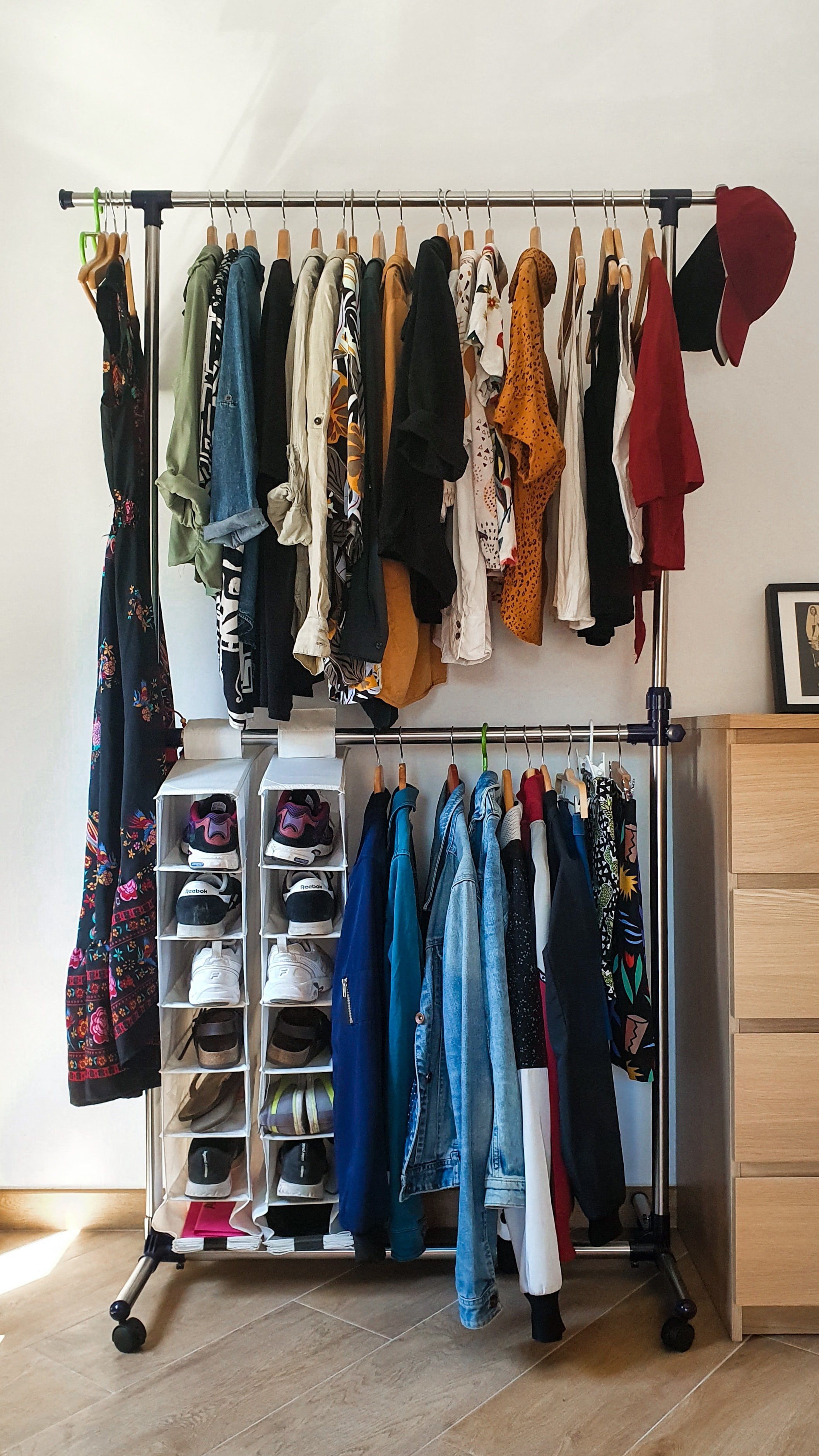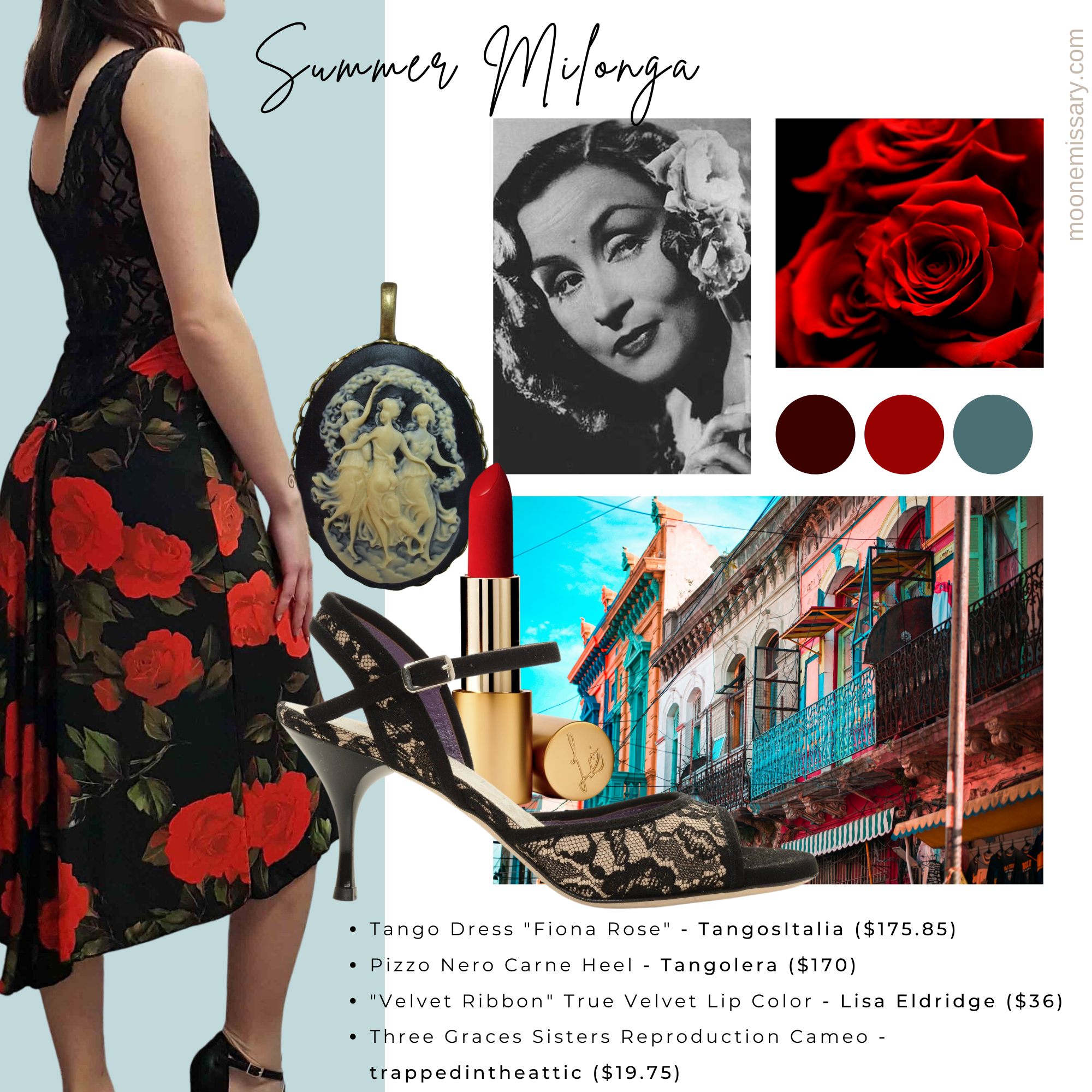How to Dress for Milongas: A Follower’s Cabeceo-Grabbing Secrets (that aren’t Cliché)
Clothing communicates many things.
It speaks to your personality, your identity, and your sense of time and place.
It also communicates that you’re ready to dance at a milonga, or Argentine Tango social.
Read on for my tips and tricks for assembling authentic, original milonga-friendly outfits that compliment and attract, with nary a fishnet stocking or red dress in sight.
Fabric 101
Choosing the Right Fabric
The secret to looking good and feeling good at milongas lies in your choice of fabric. And since milongas involve nearly non-stop physical movement and contact with others, lightweight, flexible, and moisture-wicking fabrics are your best bets for staying cool and comfortable.
Some milonga-proof fiber types to look out for are:
Smooth Operator
Linen, rayon, and cotton develop wrinkles easily. When travelling to out-of-town milongas, avoid packing fibers that require frequent steaming or ironing.
Linen. Absorbs sweat and dries quickly; ideal for daytime milongas during warm months. Looks breezy and effortless.
Chambray. An alternative to cotton, breathable and lightweight. Also ideal for warm months.
Rayon. Synthetic fibers that mimic silk. Drapes beautifully and resists wrinkles. Ideal for evening and daytime milongas in the spring. Pair with accessories and incorporate structure (such as waist emphasis) to keep rayon from looking like pajamas.
Viscose. An environmentally friendly alternative to rayon, made from wood pulp. Airy, soft, and absorbent. Note that viscose shrinks when subjected to high heat.
Lycra and jersey knit. Soft, elastic, and quick drying, these fabrics are commonly used by tango clothing designers. Wearable in all seasons; ideal for tango festivals, marathons, and travel.
Cotton blends. I find that cotton only works for milongas when it’s blended with other fibers, such as viscose, linen, and polyester. Avoid 100% cotton, as it absorbs sweat like a sponge and stays soggy like one too.
Finding Inspiration
Honor Tango’s History
You know you’re a serious milonguera when you account for everything in your dancefloor ensemble, and tango’s storied history is ripe for fashion inspiration.
In short, the music you hear at milongas is pulled from a period called the Golden Age of Tango. Occurring from the late 1920s until the mid-1950s, the Golden Age is remarkable for its rapid technological, social, and economic shifts; within Argentina alone, this period saw the rise and fall of dictatorships, economic depression, women’s suffrage, and the rapid expansion of agriculture and infrastructure.
An example of 1930s winter fashion; note the rich jewel tones, waist emphasis, and elegant bias cuts.
Fashion-wise, women’s clothing reflected the Golden Age’s shifting economic and social sensibilities, where sophistication and womanly elegance replaced the youthful, carefree spirit of the 1920s.
If taking inspiration from this historical period, look for the following cuts, colors, and details:
Bias cut, where fabric is cut at a diagonal, 45-degree angle (instead of along a straight grain). Bias cuts allow fabric to hug your figure and emphasize your natural shape.
Elegant details, such as lace, pleats, ruching, cowl, and velvet.
Saturated pastels and jewel tones. For maximum authenticity, wear saturated pastels in the warm months and jewel tones during the cold ones.
Waist emphasis, which returned after the straight silhouettes of the 1920s. Your clothing’s waistline should fall no lower than your bellybutton.
Floral and polka dot prints. Compared to today, floral prints and polka dots during tango’s Golden Age were small and dainty. White polka dots on a colored background and colored polka dots on a white background are most authentic to the 30s and 40s.
White. Pair solid colors and prints with white; during austere times, this color was economical and practical.
Modest hemlines. Hemlines remained low until after the 50s; your skirts and pants should fall no higher than your knees.
Back it Up
Exposed backs are a hallmark of Argentine Tango fashion, but know that exposing one’s back was risqué during the 30s and 40s. If opting for an exposed-back dress, treat your back like a bold, rebellious statement. Emphasize your bare skin with jewelry or titillate onlookers with a lace overlay.
Don Large Prints
Staying visible in the ronda is half the equation if one hopes to dance frequently throughout the night; catching and keeping a prospective lead’s eyes on you is the other.
Large prints, the kind that breath and flex while your body does the same, are ideal for capturing the gaze of all you pass.
Large, colorful prints are eye-catching in the dim lighting at milongas.
Go with the Flow
Drape, or the way fabric cascades off your body, is a powerful thing, especially if you’re a modest tanguera.
When in motion, loose fabric creates visual interest by extending and embellishing the lines of your figure.
There are three types of drape:
Fluid, where fabric skims your curves and moves like liquid. Think rayon, rayon-jersey knit blends, viscose, and silk. Dreamy and romantic.
Moderate. The most versatile type of drape, commonly found in everyday items like sundresses, t-shirts, and A-line skirts. Casual and effortless.
Full-bodied, where dense fabrics hold themselves away from your body. Commonly found in cold-weather and formal wear. Elegant and womanly.
For tango, fluid and moderate drape are the best, most movement-friendly varieties.
The seasons, color stories, and aesthetic photography are great ways to find fashion inspiration.
Be Strategic About Exposed Skin
I’m no prude, but I believe tons of exposed skin is too much of a good thing at milongas.
Like with the above advice to vary loose and fitted clothing items, inspire intrigue by showcasing one physical asset at a time.
For example, you could counter an exposed back with a flowy midi skirt and closed-front blouse, or you could compliment a curve-hugging pencil skirt with a cowled, long-sleeved blouse.
Experiment with Color
Argentine Tango doesn’t mean restricting yourself to black and red (though black and red certainly have their place).
Effectively incorporating color and clothing, however, requires an understanding of how shades interplay.
Here’s my top color blocking tips:
Wear four colors, maximum. The balance between clean and cluttered outfits is hard to strike; avoid overloading your look by limiting yourself to no more than four colors. Note that neutral shades – white, black, grey, brown, and navy – count in the quadcolor ratio.
Use color theory. Certain colors compliment and enhance each other due to an illusion called simultaneous contrast; create it by pairing shades that are opposite from each other on the color wheel.
Pay attention to the colors in prints; harmonize prints by selecting solid-color (or other prints, if you feel daring) clothing items that match one of the shades in the print. When in doubt, pair prints with neutrals.
Know your color season. Due to different skin undertones, hair colors, and facial contrast, everyone looks best in different color families.
Incorporate pops of color. Use lipstick, jewelry, or your tango shoes to add accents to neutral ensembles; pops of color are particularly striking against all black or all white outfits.
When in doubt about color, try incorporating different hues of the same shade (aka monochromatic color blocking).
Boldly Accessorize
Jewelry is more than just a statement in Argentine Tango.
Beside adding a fresh, low-cost spin to repeat outfits, accessories increase your visibility in the ronda and help you impart a memorable first impression when you arrive at a milonga.
Every few years, I love to refresh my capsule wardrobe with new accessories. Here’s what I look for:
Texture. Think tassels, feathers, beads, tortoiseshell, and acrylic.
Color, such as bright monochromatic hues and iridescence.
Size, as large as you can go without stretching your earlobes and intruding upon your partner’s space.
Aesthetic. Boho and alternative styles, with their diverse textures and colors, go wonderfully with tango outfits.
Play with Fit and Cut
The final secret for masterfully assembled outfits is to play with different fits and cuts.
To balance your outfits and avoid drowning out your figure, pair loose fabrics with structured items – for example, flowy midi skirts work well when accompanied by a close-fitting blouse or crop top, and vice versa for tight bottoms and loose tops.
Sew What
Side slits and midi length in skirts helps provide cooling airflow and move for your legs to move; if a skirt in your wardrobe lacks these features, ask a tailor to add them (or do it yourself, if you know how to sew) instead of purchasing new items.
Avoid
Puffed Sleeves
This trendy clothing decoration is a cottagecore lover’s dream; when applied to tango’s embrace, however, puffy sleeves disrupt the flow of your figure, by creating unflattering mounds and bulges.
Lounge Clothes
Save for leggings and harem pants (harem pants are quite popular with dancers at informal daytime milongas and practicas), avoid wearing items you’d wear to bed or while lounging around the house, especially when attending evening events during prime nights of the week.
Remember to respect tango’s nearly century-old history (and the hard work you’ve put in as a dancer) by dressing presentably.
Denim
Denim is a durable, all-purpose fabric in everyday life, but in tango, denim is different ballgame.
In addition to limiting movement, this fabric holds onto sweat like no other. Avoid it for milongas.
Denim; looks great, but feels awful when in motion.
Heavy Winter Fabrics
When the temperatures drop, it’s tempting to whip out the wool, leather, and cashmere for tango socials.
Unless the wintertime dance event is outdoors, however, dense winter fabrics will make you overheat on the dancefloor due to how they naturally trap body heat.
Save them for removable outerwear instead.
Strapless Tops and Dresses
Upper body dissociation and close, sustained physical contact are Argentine Tango’s hallmarks; when worn to milongas, strapless tops and dresses mean constant, connection-disrupting readjustments at best and wardrobe malfunctions at worst.
Plunging Necklines
Similar to strapless tops and dresses, plunging necklines guarantee wardrobe malfunctions when applied to tango.
Full-Length Wide-Legged Pants
While wide-legged bottoms create visual flair when in motion, steer clear of full-length varieties for tango, as the extra fabric creates a tripping risk when paired with heeled dancing shoes.
If opting for wide-legged pants at milongas, ensure that the hem stops no lower than your mid-shin.
Tight Miniskirts and Bandage Dresses
No one can deny the va-va-voom appeal of bodycon dresses and miniskirts, but these items are unsuitable for milongas because their tight fit restricts your range of motion. They also tend to hike up your thighs, especially if you’re endowed in the hip department…
Heavy Oversized Jewelry
The lead’s comfort should always be considered when dressing for tango events; oversized jewelry pokes, prods, and distracts.
Hosiery
Save for dance tights, which have special grips on the feet, everyday hosiery disrupts your connection with the floor and makes your feet slide around in your shoes.









